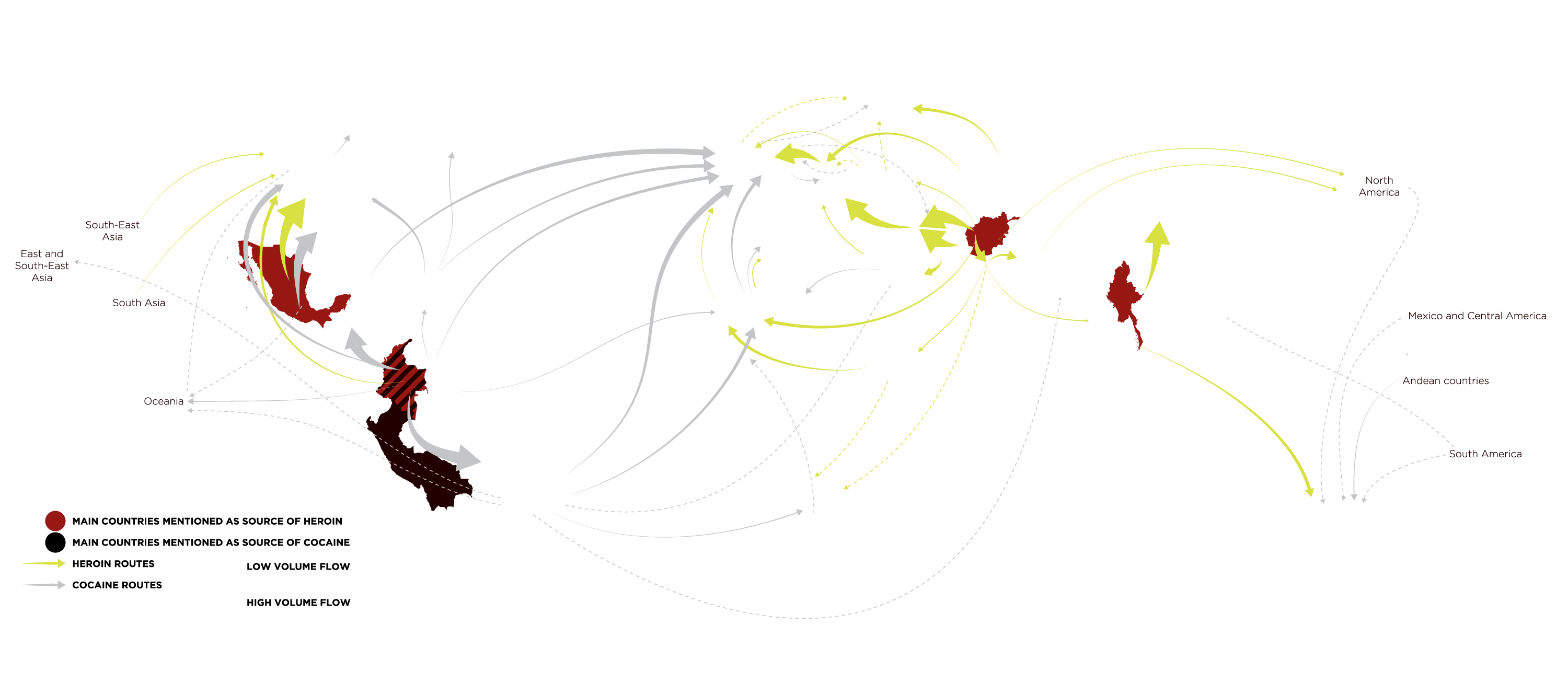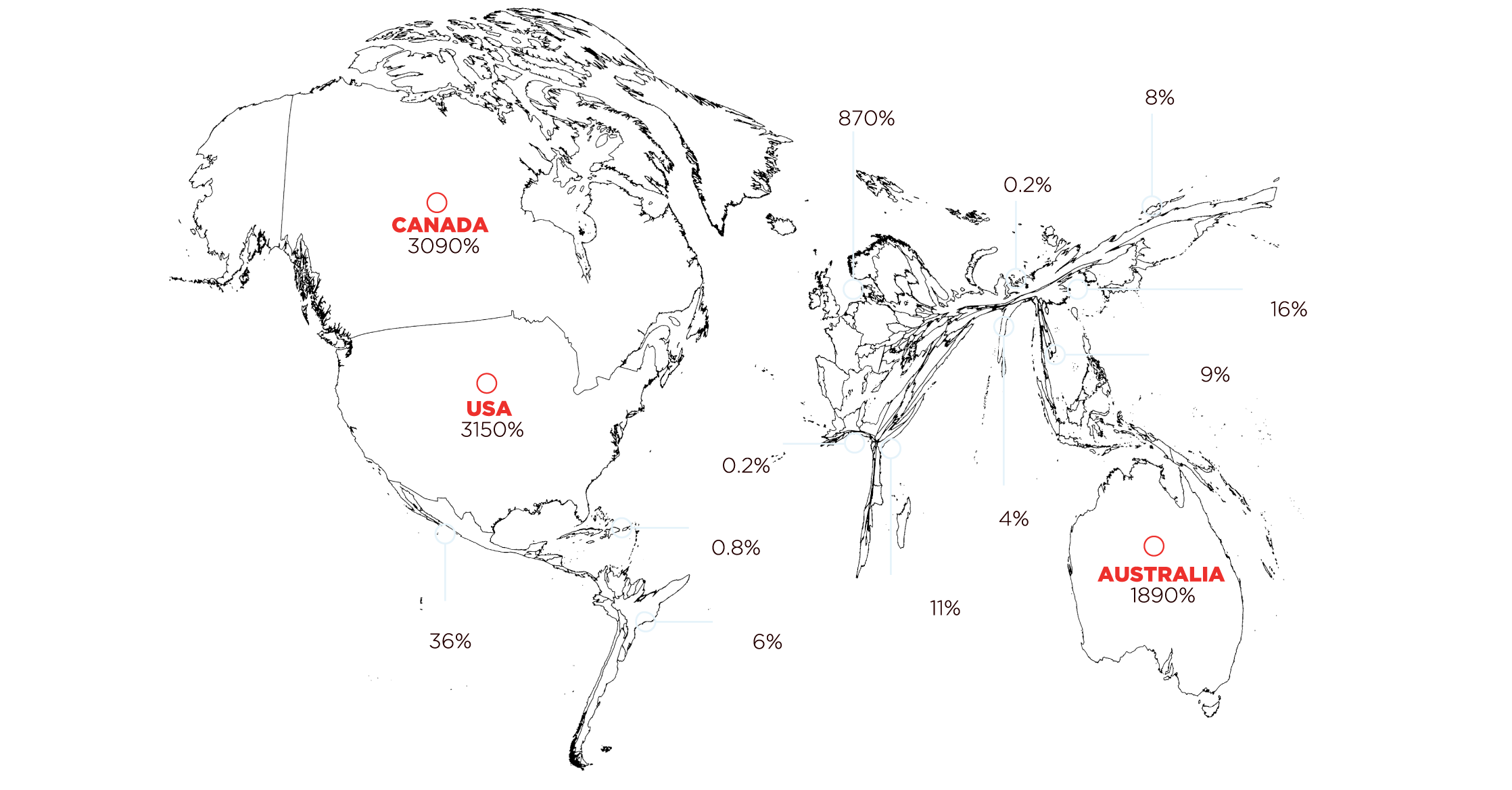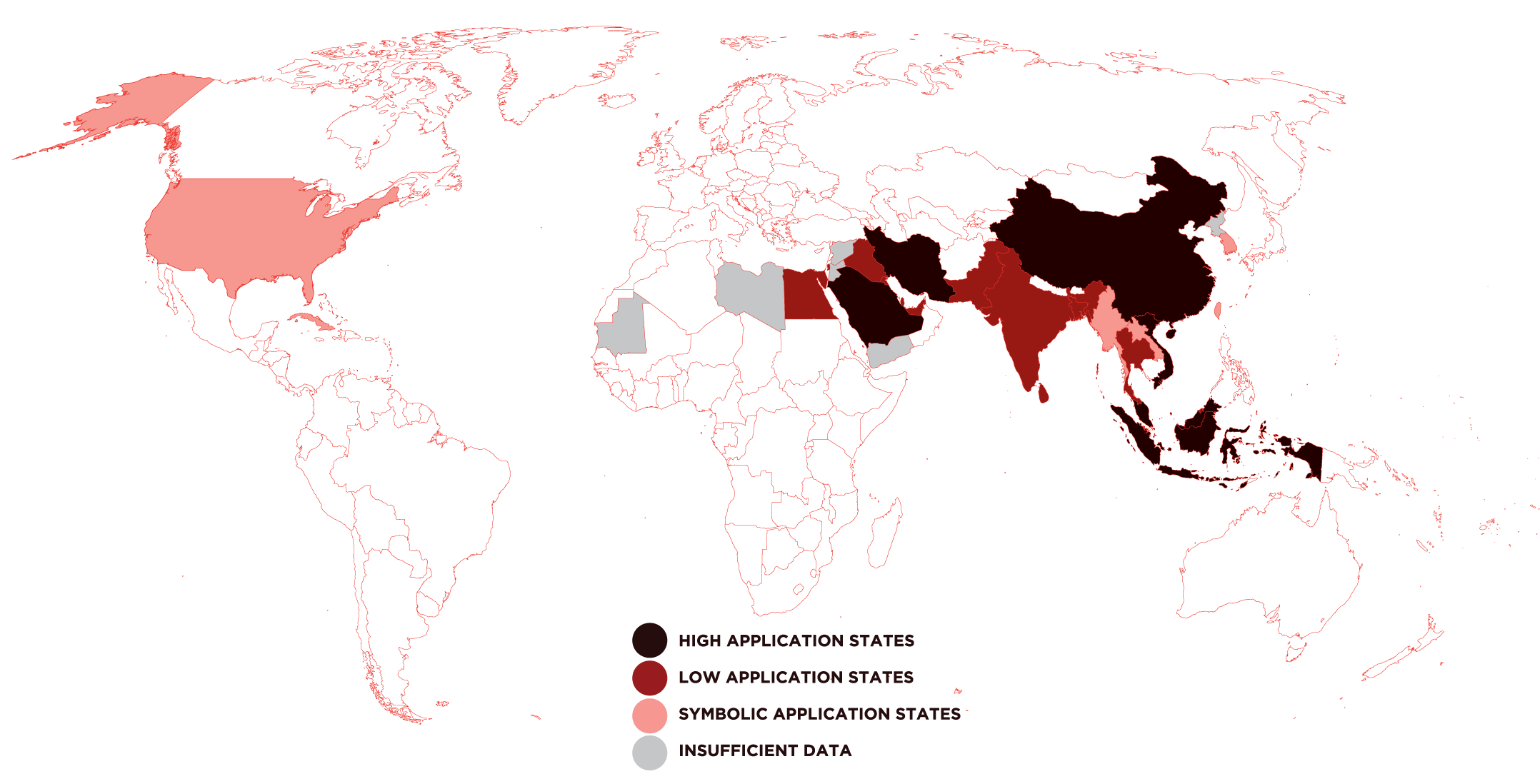


![]()
![]()
![]()
The primary aim of the international drug control regime has been to eliminate the production and use of illegal drugs while ensuring the availability of these drugs for medical and scientific research. The 1961 Single Convention on Narcotic Drugs centered the commitment of the international community to eliminating recreational drug use. Tainted by an aggressive prohibitionist approach from its inception, this approach was further heightened by the Nixon administration's declaration of its "war on drugs" in 1971.
In 2018, an estimated 269 million people used drugs globally with a drug trade value estimated at about $500 billion - an increase from 247 million consumers and $320 billion of market turnover a decade ago. Furthermore, the war on drugs has created major negative unintended consequences on global development objectives: mass incarceration, a thriving illegal drug market, the spread of infectius diseases, urban violence, and human rights violations. These negative cosequences prompted a global movement to address the problems created by drug control policies, of which this exhibition displays some of many inspiring stories from around the world.

Data source: UN World Drug Report 2020
Liz Gal lives in Sydney, Australia. She started injecting heroin and methamphetamine when she was 16. Liz has struggled to find support that would minimize the health and social harm caused by drugs. Today, she is an experienced consultant and peer support worker.
Photo credit © Nigel Brudson
Around 289 million people are using drugs worldwide and some 35 million people are estimated to have problematic drug use. Criminalization and stigma operate as major obstacles to services. People who inject drugs are at a far higher risk of acquiring HIV, hepatitis, and tuberculosis. The result is a major public health crisis.
For more information click here.
Volunteers from the Audrey Ryikov Foundation distribute free syringes and condoms to more than 3,500 people in Moscow. The foundation is one of the only grassroots organizations that provide such services in the Russian Federation, the country with the world's largest population of people who inject drugs, most of whom live with HIV and hepatitis C.
Photo credit © Mark Adveev
Thomas Synan, police chief of the Newtown Police Department, Ohio, radically changed his approach to drug use in 2014 after witnessing the death of an entire family from drugs. He is now a speaker for the Law Enforcement Action Partnership, a non-government organization that gathers law enforcement officials who advocate for drug policy reform, including alternatives to incarceration, as well as legalization and regulation of all drugs.
Photo credit © Liz Dufour / USA Today
Overdose deaths from opioids or stimulants have soared in the last decade. In the United States alone, a record 81,000 people died from overdoses last year. The use of synthetic substances that are potent and easy to produce has exploded in response to demand as drug traffickers easily adapt to the current control system.
For more information click here.
A woman uses the services of Quai 9, the supervised drug consumption centre here in Geneva. Run by ‘Première Ligne’, the centre offers access to lifesaving opioid antagonists and provides health and social services to people who use drugs. When rates of HIV infection soared from the sharing of needles in the 1980s, authorities responded by adopting a "four pillars" strategy: prevention, treatment, harm reduction and law enforcement. Today, there are 17 supervised centres in different cantons.
Photo credit © Max Jacot / Première Ligne
Rehema Kingazi from Tanzania is living with cancer and HIV. Due to drastic restrictions on importing and using opioid-based medications in Tanzania, Rehema had to face severe pain for several years before civil society groups and medical professionals introduced pilot trials of essential controlled medicines.
Photo credit © APCA
Twelve substances scheduled as illegal drugs are also classified as essential medicines for pain relief, palliative care, and mental health. The drug control system was intended to restrict illegal drug use while making essential medicines available. But the focus on prohibition has choked off access to essential medicines. Today, about 5.5 billion people have little or no access to opioid analgesics such as morphine.
For more information click here.
Dr. Rajagopal talks to a patient in the palliative care unit of Arumana Hospital in Kerala, India. Dr Rajagopal is known as the father of palliative care in his country. Founder of Pallium India, a successful community-based palliative care programme, the organization has made significant progress in broadening access to morphine in India.
Photo credit © Tom Price
![]()
![]()
![]()
The war on drugs has led to major negative unintended consequences, affecting public health, fuelling over incarceration and human rights violations, and spreading violence. The criminalization of drug use and the application of harsh punishments for drug related offences has destroyed the lives of hundreds of thousands of people, particularly the most vulnerable.
In 2008 the United Nations recognized the major "unintended" negative consequences of drug control policies. It is now time for reform.

Data source: The Lancet, 2018
Nicolas Manbode from Mauritius was sentenced to prison for the possession of less than 1g of heroin in 2010. While in prison he continued injecting heroin, sometimes sharing a needle with 100 others. Upon his release, he was diagnosed with HIV. Today he is an advocate with AfricaNPUD, the African network of people who use drugs.
Photo credit © Morgan Fache / ITEM
Since the 1960s, almost every legal system has used incarceration as the sole deterrent to drug-related activities. Apprehending large numbers of easy-to-arrest non-violent consumers has come to dominate the quest to shut down the illegal drug market. Nowhere, however, has incarceration for use or possession of drugs helped to curb the illegal market. Instead, it has served other political and economic interests on the back of marginalized and criminalized populations.
For more information click here.
A doctor conducts a counselling session at a centre for people dependent on drugs in Porto, Portugal. In 2001, Portugal became one of the first countries to remove criminal penalties for the consumption of all drugs. People caught with drugs for personal use can be summoned before a panel of psychologists, social workers, and lawyers.
Photo credit © Markel Redondo
Rosemarie Santiago poses with her son Jericho at their home In Manila, Philippines. Rosemarie was Incarcerated on drug charges when she was pregnant and gave birth to Jericho while in prison. She was forcibly separated from her son a day after his birth and did not see him for the following 9 months.
Photo credit © Hannah Reyes Morales
Women pay a high price for using drugs or engaging in the illegal drugs trade. They often experience violence, abuse, and separation from their children. Public health services or prisons are seldom adapted to their needs. In 2017, more than a third of women and girls held in penal institutions were incarcerated for non-violent drug-related offences.
For more information click here.
Susan Burton started drinking and using crack cocaine after the tragic death of her 5 year old son. Because of her dependence, she went In and out of prison at least 6 times over nearly 20 years. Today she Is a renowned advocate and founder of A New Way of Life, an organization based in Los Angeles, U.S.
Photo credit © Dario Griffin
A Catholic nun attends the vigil for Rodrigo Guiarte in Jakarta, Indonesia, following his execution by a firing squad in April 2015. Together with 8 other foreigners, Rodrigo Guiarte was sentenced to death for smuggling 6 kilos of cocaine inside surfboards into Indonesia.
Photo credit © Nyimas Laula / Reuters
In at least 35 countries, some drug charges are punishable by death. Worse, many jurisdictions have a mandatory death penalty, denying judges their basic freedom to judge a case. Over 7,000 people are on death row for drug offences, while lengthy prison sentences for drug use are common. Disproportionate sentences increased after the adoption of the United Nations Convention Against Illicit Traffic in Narcotic Drugs and Psychotropic Substances of 1988.
For more information click here.
Abolished in the Philippines in 2006, the death penalty is currently being reinstated exclusively for "heinous" drug trafficking crimes by the Duterte Administration and his war on drugs.
Photo credit © aT.RMA / Shutterstock
![]()
![]()
![]()
Over the last 20 years the volume and the types of illegal substances and the reach of criminal organizations through new trafficking routes grew significantly. This market boom has empowered criminal groups and led to more sophisticated links between them, threatening democracies and global security. On the other side of the balance, farmers have little alternatives and low-level actors are disproportionately punished.

Data source: Harm Reduction International
U Bo, a subsistence Farmer in eastern Myanmar, amid his 2 acres of poppy fields. The 6 kilos of opium he produces every year could fetch about $1800 barely enough to look after his family of seven. “We would like to have power, roads, water – then I don’t have to grow poppies”.
Photo credit © Paul Vrieze
Without infrastructure and job opportunities, millions of subsistence farmers have no other choice than to cultivate illegal crops for survival. Despite the recent shift in the global discourse from eradication to sustainable development, nothing has changed for farmers. Crop eradication campaigns continue without regard to livelihoods and the environment, fuelling human rights violations and violence.
For more information click here.
Imitating her parents, a girl pours coca leaves into 50-pound sacks in La Paz, Bolivia. Once filled at AOEPCOCA (Association of Coca Leaf Farmers), the sacks are distributed at several markets around the city. The leaves are sold by the pound to consumers who chew on the leaf or manufacture products like wine, cookies, bread and medicines.
Photo credit © Carlos Villalon
In September 2017, nearly 1000 Brazilian soldiers encircled Rocinha, Rio de Janeiro’s largest favela, after intense gun battles between the police and rival drug gangs fighting for the control of the neighbourhood. Amid gunfights, the military operation forced schools, businesses, and hospitals to close.
Photo credit © Marcelo Sayao / Alarmy
Ineffective regressive drug control measures have escalated to the militarization of civil security. Some governments, especially in central and south America, continue to fight drug trafficking by deploying military forces that are not trained to be deployed to city streets, resulting in a brutal increase in violence.
For more information click here.
Mexican activists protest outside the Senate in Mexico City in December 2017 against a law that proposed the militarization of public security. The signs read “No to militarization in the country”. In November 2018 Mexico’s Supreme Court ruled the law unconstitutional in its entirety.
Photo credit © Carlos Jasso / Reuters
Anabel Hernandez is a Mexican journalist who uncovered a series of links between politicians and the Sinaloa Cartel, one of the world’s most powerful criminal networks. The cartel carries out drug trafficking and money laundering operations over 70% of the world’s territory, spreading corruption and violence. It has an estimated annual revenue of $3 billion.
Photo credit © Adam Wiseman
Illegal drug markets provide an unequalled source of revenue for organized crime groups. The UN estimates that over half of the gross profits of illegal drug markets are laundered through global financial systems. According to Europol, over 99% of drug revenues laundered in Europe are never recovered by authorities.
For more information click here.
Lanny Breuer, Assistant Attorney General at the U.S. Justice Department, speaks about HSBC’s involvement in the laundering of $881 million from drug trafficking proceedings at a press conference in December 2012. In 2020, the FinCEN files denounced that nearly 90 financial institutions facilitated money laundering through more than $2 trillion in suspicious transactions.
Photo credit © Joshua Lott / Reuters
Concerned with the failure of the drug control system and the negative consequences of the prohibitionist approach, global leaders created the global commission for drug policy ten years ago.
Driven by their sense of responsibility, the Global Commission broke the taboo surrounding drugs, challenged old convictions and brought evidence to the international debate.
In 2021, the Global Commission celebrated its 10-year anniversary with renewed hope. The drug policy landscape has changed. Countries are recognizing more and more the harms caused by punitive policies and many have started experimenting new models based on evidence and in respect of human rights.
It is time to recognize that there will not be a world without drugs. Countries must focus on minimizing the harms, offering care for those in need, not prisons. At the same time, governments must take the control of this market and disempower organized crime.

Data source: David Bewley-Taylor, Martin Jelsma and Sylvia Kay. "Cannabis Regulation and Development: Fair(er) Trade Options for Emerging Legal Markets". International Development Policy. Revue international de politique de développment [Online], 2020.
The Global Commission on Drug Policy extends its warm and grateful thanks to the people and organisations that have made this exhibition possible through their contributions. The Global Commission also recognizes the people working tirelessly to revert the harms caused by years of punitive and repressive drug policies. They include the many civil society organizations working in the drug policy, health, social and human rights fields, but also brave individuals that, along with their families and loved ones, had their lives affected by unneeded over-repression and stigma, yet still fight today for a shift of paradigm.
This is the online version of the Global Commission's exhibition War on drugs: tales of resilience from around the world, which was organized in Geneva in 2021.
Coordination: Isabela Barbosa, Ramon Moraes Sales Moura
Design and conception: John Abou Elias, Delphine Judith
Consultant: Juan Gelas, for 2gether Communication